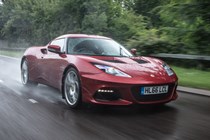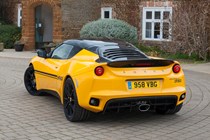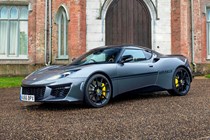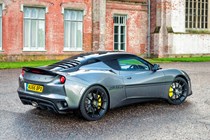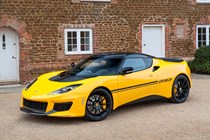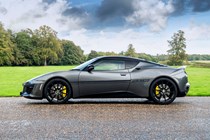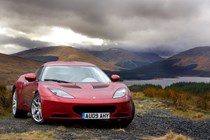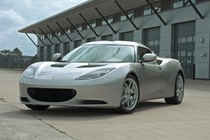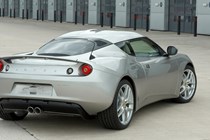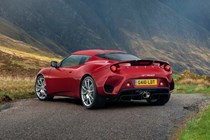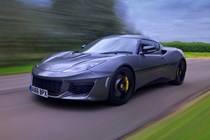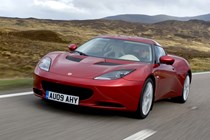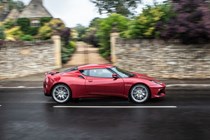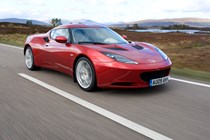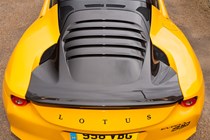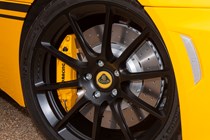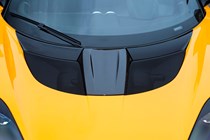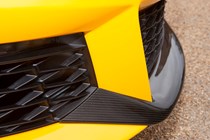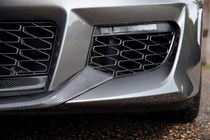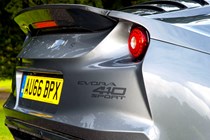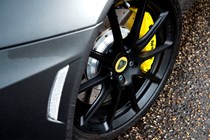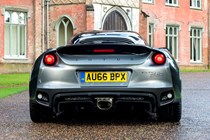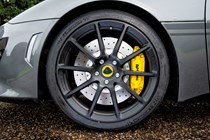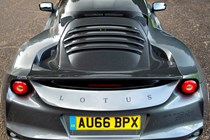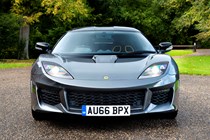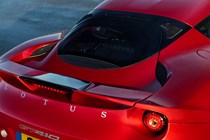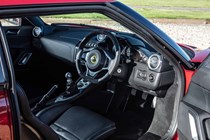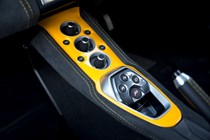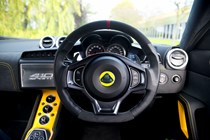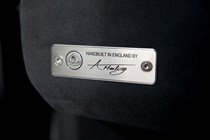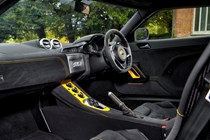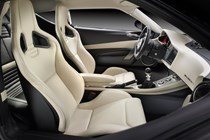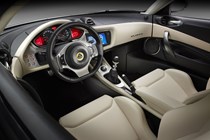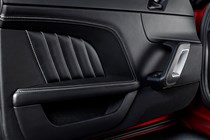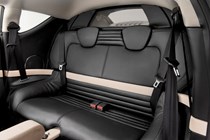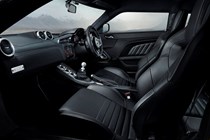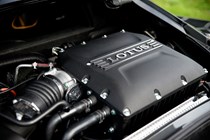
Lotus Evora Coupe (2009-2021) engines, drive and performance
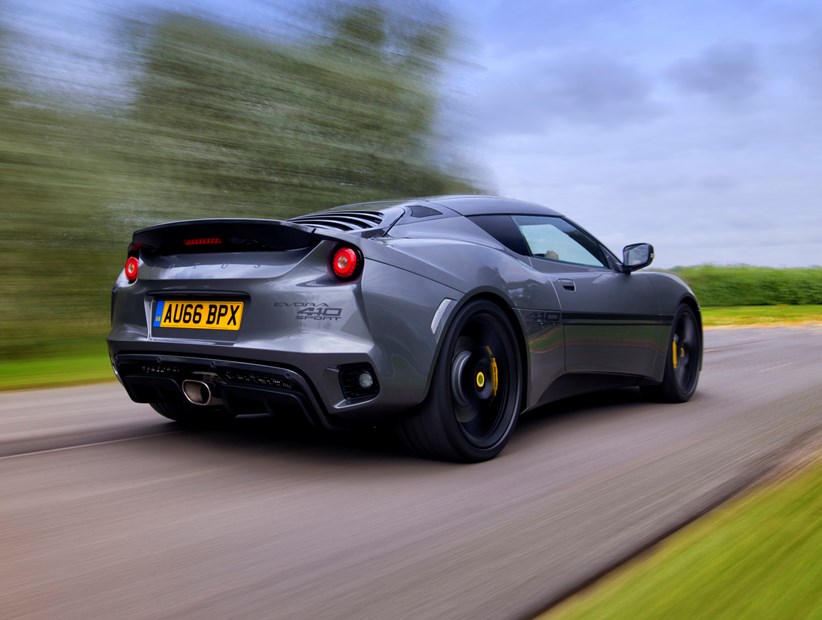
- Single engine choice, a 3.5-litre petrol V6
- One of the best powertrains on sale
- Smooth, torquey delivery with sensational noise
There’s only one engine choice for the Lotus Evora whether you pick a GT410 or GT410 Sport, and it’s a 3.5-litre V6 petrol from Toyota with the addition of a supercharger that lifts the power output to 416hp. It’s an old-school powerplant with a real enjoy-now-while-you-can feel.
The GT410 produces 410Nm of torque and the Sport adds 10Nm more, although both sprint from 0-62mph in 4.2 seconds, the same as the fastest Porsche Cayman. Although that car has a muted, turbocharged four-pot.
With its aerodynamic shape the standard car can reach 186mph, while the GT410 Sport is capable of 190mph – these are proper supercar numbers – although if you pick the automatic gearbox that drops to 174/171mph.

Not a numbers car
However, this is a car that’s more than the sum of its parts, and provides an experience that is hard to convey with figures alone. The only number that really matters is 4,500rpm, the point at which the engine is fully on-song and the valve in the stainless steel exhaust is wide open. Here the Evora sounds like no other car on sale today, aside perhaps from the Exige Cup 430. You will be completely unprepared for the noise it makes.
At lower engine speeds with the exhaust closed it’s quiet enough to creep past a Cotswolds post office without disturbing the stamps, so long as you shift up early enough to avoid the switchover point. Alternatively, if you decide you need all of the noise all of the time, there’s a button on the dashboard that leaves the exhaust wide open regardless of revs.
This enables the full range of tickover burble, midrange snarl and top end howl that’ll have you revving out second gear from crawl to redline over and over. Be aware though, you will be audible from the next village.

The Evora’s power delivery is just as characterful. It doesn’t feel entirely naturally aspirated, you still need to keep it spinning in its upper reaches to access its sharpest throttle response, and that inconsistency makes it easy to over- or under-rev a blipped downshift. But that just makes it all the more gratifying when you get it right, and besides, it’s much more linear than a turbocharged engine, pulling hard right up to the rev limiter.
Equally the manual gearbox requires concentration to get the best out of. It’s not light and crisp like a Cayman’s, the shifter (and clutch pedal) is mechnical and uncooperative if rushed, and if you fail to time it right the result will feel jerky. However, pick the exact point in the rev range, take time to pause in the neutral position between gears and feed the clutch in gradually, and satisfaction in the resulting seamless surge of power is unmatched. And so the obsession with nailing every shift begins.
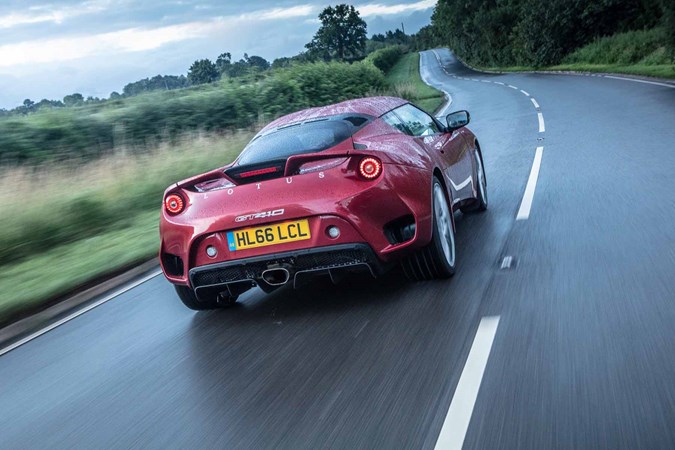
We’ve touched on it briefly but there’s also an automatic gearbox available for the Evora – we tried one a few years ago and thought it was fine, but nowhere near as involving as the manual. As if you needed me to tell you that.
Engines previously available
Parkers drove the old Lotus Evora when it had just 276hp and 350Nm of torque, and didn’t fall quite so in love with the noise. In fairness, it’s with the latest generation that the Evora has become so sonorous, and back then there was a motorsport-esq six-cylinder Porsche Cayman on offer.
If that model sounds down on power, it’s because the standard car had no supercharger. If you wanted more in the form of forced induction then the Evora S could oblige, with 345bhp and 400Nm of torque.
This version had plenty of clout for overtaking and the engine was so torquey and flexible that you rarely needed to change down a gear to unlock strong acceleration.
Still, performance was a way off what the Evora is capable of today – the standard car clocked a 0-62mph sprint of 5.0 seconds (5.2) and went on to 163mph (159mph) while the S was capable of 4.6 seconds (4.7) and 178mph (167mph) – the figures in brackets there are for the auto ‘box.
Following this was the supercharged Evora 400, with as you’d guess, 400 imperial horsepower (406hp in metric) and the Sport 410 that featured even more punch.
Finally Lotus released the GT430, the fastest and most powerful Evora model to date, with 436hp and 440Nm of torque – this dispatched the 0-62mph run in 3.8 seconds and topped out at 190mph.
Only 60 examples of this most hardcore Evora were built and it came as standard with a gearbox cooler and titanium exhaust. That’s a feature I loved on the Exige Cup 430 because it makes even more noise and frankly, because titanium is cool.
Handling
- Remember steering feel?
- Softer GT410 is the better B-road car
- Even more spectacular on track
The best Evora for UK roads is the comparatively softer GT410. This car came about when the boss of Lotus was so impressed by the more compliant American market Evora GT, he set about producing a version for the UK.
That’s interrupted Lotus’s path of producing cars capable of faster and faster lap times at its Hethel test track, which required harder suspension and less of a consideration to comfort with every generation, as demonstrated by the more focussed GT410 Sport.

We’ll explore this in more detail in the Comfort section of this review but the more biddable damper set up in the standard GT410 enables it to track the various surface defects and gradient changes on rural roads – the kind you’ll want to drive it on – more successfully than a stiffer set up, in terms of refinement and outright grip.
It also benefits from the softer sidewalls of Michelin’s Pilot Sport 4S tyres, instead of the GT410 Sport’s Cup 2s. This is a proper GT – a car you’d be more than happy to do a long journey in.
So – softer suspension, less serious tyres, hydraulic power steering (which most of Lotus’s cars do without) – this is hardly the benchmark recipe for handling prowess, and yet the Evora manages to offer levels of dynamism and comfort in the same package that other manufacturers could only dream of. And remember this is a normal, non-adaptive set up, albeit it one provided by motorsport-grade Bilstein dampers and Eibach springs.
Let’s start from the ground up. Those road-biased tyres summon up a level of grip in the dry that is hard to fathom, and unlike the more racey Cup 2s, can do so confidently in all weather conditions.
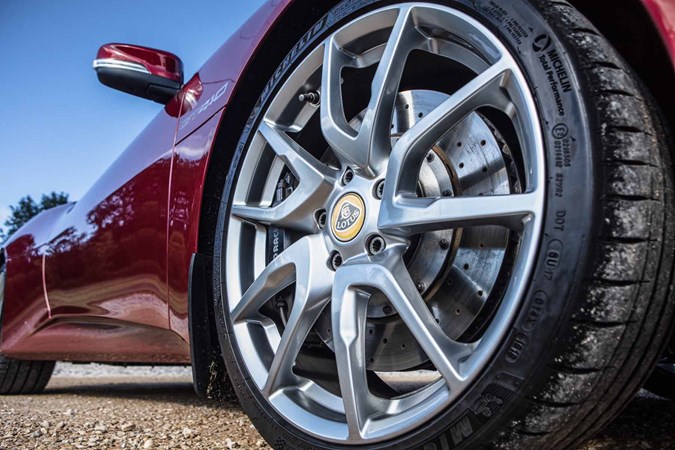
That’s a vital piece of the Evora puzzle, a car that pulls away from rivals not because it’s got twice the horsepower, but because it can maintain such high speed in a corner. The front end is permanently pinned to the tarmac, meaning you can turn into bends that you’d normally brake for without lifting the throttle.
It doesn’t handle completely flat, there’s a bit of body roll that more hardcore rivals like the Porsche Cayman GT4 or even Alpine A110S have dialled out, but if anything this gives you a better idea of what the car is doing beneath you, and is well controlled enough to not be a nuisance. Then there’s the steering, which writhes around in your hands over rough ground and feels so intuitive to use, so perfectly weighted.
On a circuit and with a bit of room for manoeuvre you’ll soon find yourself scrolling through the drive modes (standard, Sport and Race) gradually winding the traction control’s interference off. But even in its slackest mode the Evora is a confidence inspiring thing, with huge mechanical grip and chassis clarity, so it always feels predictable and safe.
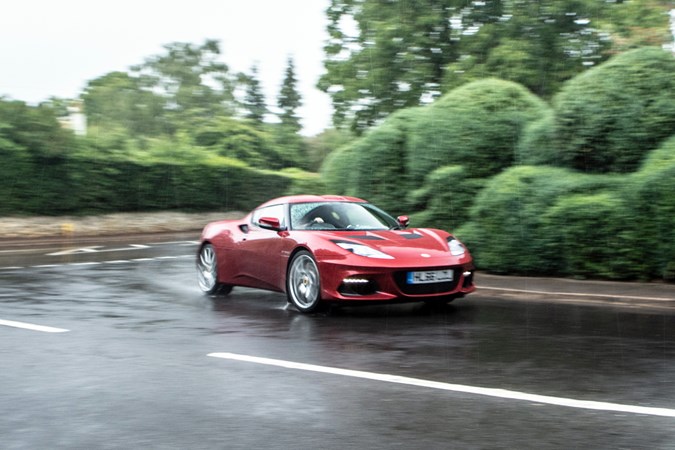
Being a bit of a featherweight means the AP Racing brakes have an easier job of hauling the Evora up time after time. They need a bit of a push of the pedal to get them to bite, but this makes it easier to modulate their power when driving fast.
Sorry to hark on about it, but the way this car can almost float its way down a bumpy road while still delivering thrills you thought had been long since phased out by numb steering, overly assisted sports cars is peerless. What an all-rounder.
GT410 Sport
If all that long-legged GT softness is the bottom of your list of priorities then you might want to consider the GT410 Sport – a car that still nods at comfort while turning up the wick on agility, precision and response.
A race suspension package employs Ohlins TTX dampers, which are 13kg lighter and deliver a more track-biased set up, while a maximum 96kg off downforce keeps the tyres squashed into the road.


